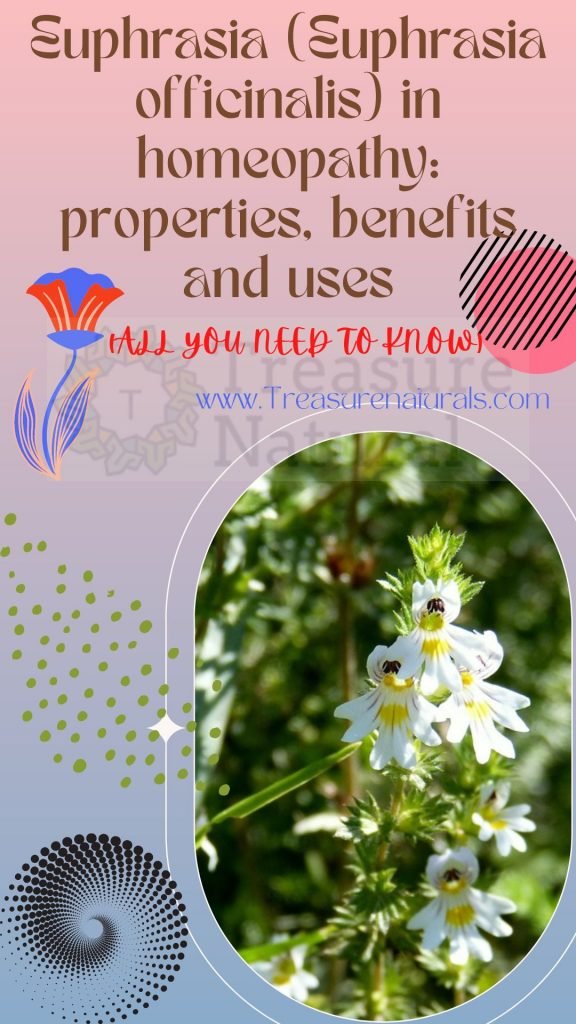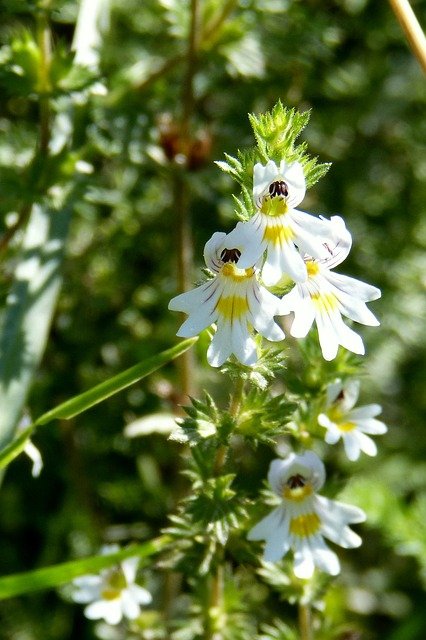
The homeopathic remedy Euphrasia is obtained from euphrasia (Euphrasia officinalis), a small and graceful plant belonging to the Scrophulariaceae family. In Homeopathy it is one of the most important remedies to treat eye diseases, but it is also used as a strengthener of the mucous membranes.
Euphrasia : History and characteristics of the plant
Euphrasia is a small plant with great beneficial properties: in nature there are about 450 species, among these the most exploited in ancient folk medicine (and later in Homeopathy) is undoubtedly the Euphrasia officinalis.
Euphrasia is a genus called hemiparasite, in fact it manages to thrive on the roots of other plants by subtracting water and mineral salts from them; unlike parasitic plants, hemiparasites can perform the chlorophyll function. This plant, widespread in Europe, northern Asia and North America, is composed of white flowers, with purple streaks and a round yellow spot.
The aerial parts of euphrasia contain lignans, glycosides, acids-phenols and an essential oil, which give the plant anti-inflammatory and antibacterial action, supported in particular by the presence of iridoids, flavonoids and tannins (euphrasiotannic acid).
Recommended for eye problems by the Greek botanist Theophastus (IV century BC.c) and the Greek physician Dioscorides (I century BC.c), it received little attention, until all its medicinal properties were discovered in the fourteenth century. The first documentation dates back to 1305, when Nicholas Culpeper attributed to euphrasia the properties of strengthening cognitive abilities and memory. Subsequently, its properties were used mainly for the treatment of eye diseases but also for cough, hoarseness, earache and headache.
Even according to Paracelsus signature theory (according to which the disease and the suitable remedy had common characteristics), euphrasia is particularly suitable for eye health: in fact, euphrasia is not only called eye grass for its properties, but also for the shape of the flowers that vaguely resembles an iris.
In the Middle Ages euphrasia was used as incense for spiritual rites while in the agricultural field it was not much loved because it inhibited the growth of other plants by reducing the yield of the crop.
The name “Euphrasia” was introduced by the botanist Linnaeus in 1735 in the scientific classification of plants: the term comes from the Greek word “euphrosyne” which means contentment.
Euphrosyne was one of the three Graces, famous for her joyfulness. Legend has it that the plant was called by its own name because it too, taking care of the sight, brought happiness in the lives of those who used it.
In the eighteenth century euphrasia began to receive special attention even at the court of Queen Elizabeth, it was in fact used as tea.
Euphrasia : homeopathic remedy and properties
The homeopathic remedy Euphrasia is obtained from the whole plant harvested during flowering and is mainly used as a first aid remedy for visual disturbances ranging from swollen, tired and inflamed eyes to eye injuries.
It has an anti-inflammatory, antibacterial, antiallergic, anti-inflammatory and decongestant action and is traditionally used in the following cases:
- eye pain;
- photophobia;
- feeling of eye pressure;
- conjunctivitis;
- tearing;
- blepharitis (inflammation of the eyelids);
- corneal ulcers;
- iritis (inflammation of the iris);
- cold accompanied by red cheeks and watery phlegm;
- hay fever with eye disorders;
- headaches;
- painful and short menstruation in women;
- inflammation of the prostate gland in men.
In addition to anti-inflammatory properties, euphrasia also plays a powerful antiallergic action on the mucous membranes that makes it a perfect remedy to cope with those situations in which swelling and eye redness are caused by allergy.
The homeopathic remedy euphrasia for for eye disorders
Eye disorders are very common, in fact almost all people at some stage of their lives can suffer from them.
Some eye problems are defined as temporary and these include conjunctivitis, stye, redness and a feeling of dry eye. These are transient and non-serious disorders that can arise from different causes such as fatigue, allergies, viral or bacterial infections and more.
Then there are the long-lasting eye problems such as blepharitis, glaucoma, cataracts or dry eye.
In general, Homeopathic Medicine recommends Euphrasia as the remedy of choice in all cases of conjunctivitis, allergic rhinitis, blepharitis, stye, eye fatigue, excessive tearing, irritation, burning, redness and eye disorders of muscular or nervous origin.
Since the scope of the homeopathic remedy Euphrasia in the treatment of eye problems is very wide, it is always better to consult your doctor before intervening on a certain problem.
Euphrasia: constitutional type

The constitutional type Euphrasia usually has dark hair and is often melancholic and loves loneliness. He lives misfortunes with deep emotional participation and is very difficult to console.
Below are the main characteristics of the remedy in reference to the subject for whom it is particularly indicated:
General action:
- ocular mucosa;
- nasal mucosa.
Generality:
- allergies;
- virosis;
- action of irritants the conjunction;
- feeling of sand in the eyes and disturbed vision.
Main clinical indications:
- conjunctivitis of different origin;
- allergic rhinitis;
- vasomotor rhinitis;
- measles (stage of mucositis).
Usually the presented symptoms of the subject improve in the dark; they get worse with sunlight, heat and wind.
In any case, eye grass can be used by anyone with eyes that are particularly sensitive to atmospheric phenomena, such as sun and wind through beneficial compresses and specific eye drops.






